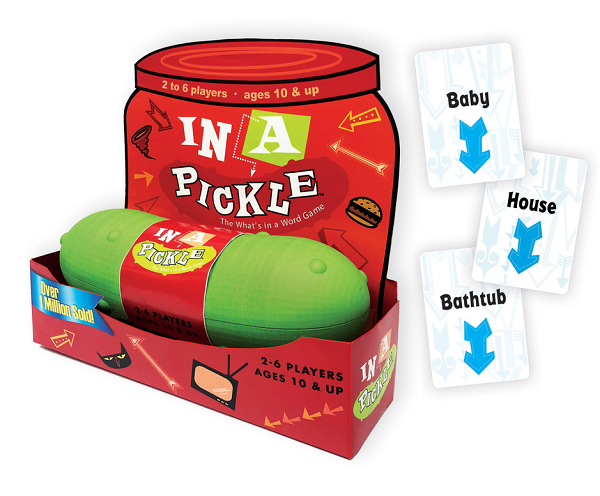What Fits Inside? Think Spatially in Gamewright's In a Pickle

There’s love in the family, and the family is in danger, and there’s danger in the house. What comes next that the house can fit into?
Published by Gamewright Games, In a Pickle is a light party game for two-to-six players, all about making connections between words, with nouns that can fit inside each other.
Gameplay
The cards are shuffled and each player is dealt a hand of five. Each card shows a noun. Four cards are then placed in the center of the table, forming four columns. On your turn, you try to play a card either to the top or bottom of one of the columns. You may play it at the top if the word on your card could go inside the word at the top of the column — for example, you could play ‘leftovers’ above ‘refrigerator’. You can play a card at the bottom of a column if the word at the bottom of the column is something that could go inside your word — for example, you could play the word ‘house’ under the word ‘danger’ because danger could be inside a house. When adding cards to a column, you only need to consider the card you are directly playing your own card next to, so even if your card wouldn’t make sense with another card elsewhere in the column, it is still a legal play.
You are encouraged to get creative with your plays, but another player can challenge whether your card was legally played. In this case, you may make a short defense as to why it was, and then the other players vote. If they vote against you, you must discard your played card and your turn ends.
If you do not have a card to play or do not wish to play a card on your turn, you may pass and discard up to three cards. Regardless of how your turn went, you draw back up to five cards at the end of the turn.
When any column reaches four cards, you immediately go into a pickle round. During a pickle round, each player has the chance to pass or add a card to the bottom of the column (following standard rules), ending with the player who originally added the fourth card to the column. The player who adds a card to the column last gets to pick it up and add it to their scoring pile. The first player to win a certain number of columns wins the game.
There is also an alternative ruleset in which all cards in the row must make sense together and connect.

Review
In a Pickle is so much fun. It’s fun to come up with creative ways to play cards, or to see the stories that build as more cards connect to each other. It’s fast, it’s goofy, it’s different. It’s very satisfying to trump a row during the pickle rounds, or when you have nothing to play until the player right before lays down a card that fits in nicely, with some clever interpretation, with one of your own.
If you don’t like the challenges and defenses, the alternative gameplay offers less room for them and it can be an awful lot of fun to see how the cards connect together to build unusual and often funny scenes.
The deluxe game we played comes packed in a pickle-shaped box, which is definitely a bit awkward to store on your game shelf. People with limited shelf space or careful organizational systems might find it annoying, and might opt for the original boxed version — but the deluxe version is definitely eye-catching and the cards are nicely designed to be easy to read.
A fun party game that has you thinking outside the box, In a Pickle can be both tricky and humorous. Best with groups that aren’t going to get too caught up in the arguing, it’s light, fast, and quite amusing.
Pros: Creative, two fun game modes, fun to come up with unusual ways to connect words
Cons: Pickle-shaped box might by annoying for storage
Disclosure: we received a complimentary review copy of this game.







